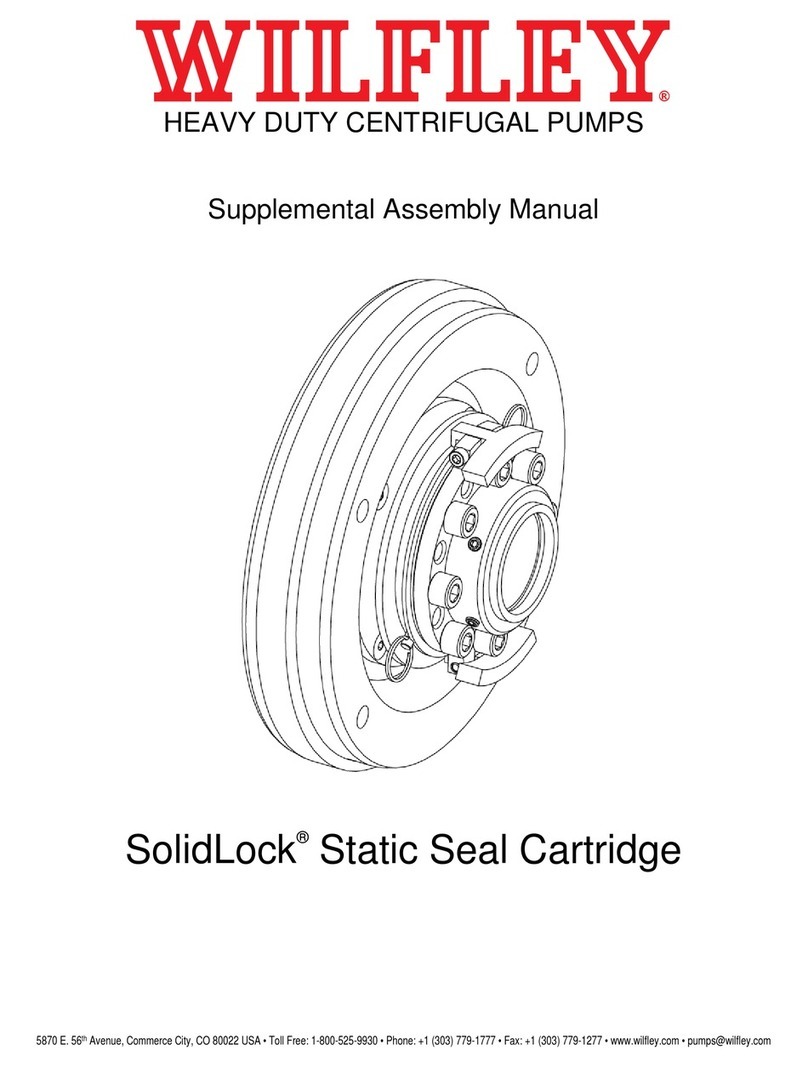
2 A2551 rev B
C
E
N
T
R
I
F
U
G
A
L
P
U
M
P
S
1.0 INTRODUCTION
This manual contains instructions and guidelines
for the installation, operation, maintenance and
storage of the Wilfley A7 ANSI Standard Pump.
There are many factors affecting the successful
installation, operation and maintenance of a
pump. From one pump to the next there is
typically significant variation in these factors. This
makes it impossible to create a bulletin that
covers all situations.
Therefore, the information contained herein is
meant to serve only as a general guideline. If
detailed questions or problems arise, contact the
Wilfley Sales Office or authorized
Distributor/Representative.
It is extremely important that this entire
manual be read prior to installation or start-up
of the pump.
This is important for safety, for proper
performance of the pump and for maximum Mean
Time between Planned Maintenance (MTBPM).
2.0 SAFETY CONSIDERATIONS
Like all machinery, centrifugal pumps can be
dangerous if used improperly. Any of the following
misuses may result in a pump that does not
function properly. A pump that does not function
properly may be a hazard and could cause
damage or injury.
For maximum safety and reliability, use only
factory-supplied parts and closely follow all
maintenance and operating recommendations and
instructions.
Do not change the pumping conditions or
installations of a Wilfley pump without consulting
A.R. Wilfley and Sons, Inc. first to ascertain if the
pump is capable of handling the new conditions
and/or fluid. It is not possible to list all the
conceivable misuses. Therefore, the following list
is not meant to be complete and is provided only
as a guide of the types of misuse that can
damage a pump and cause injury. The list will
also give a good idea of the kinds of misuses that
will void any and all warranties.
1. Do not run a pump with the discharge valve
closed or below minimum rated flow.
2. Do not run a pump in the reverse direction.
3. Do not start a pump that is “wind-milling” in
the reserve direction due to fluid flowing
back down the discharge pipe.
4. Do not continue to operate a pump when
there are indications that something is
rubbing, binding or knocking.
5. Do not continue to run a pump that gives an
indication of overheating.
6. Do not operate a pump with the coupling
guard removed. Make sure the guard fits
snugly around the coupling so there are no
openings.
7. Do not operate a pump that is excessively
vibrating, surging or making abnormal
noise.
8. Do not work on a pump unless the drive
system is locked out and the pump is
disconnected from the drive system.
9. Do not connect the pump to the drive
system without first checking to see that the
drive system is running in the correct
direction.
10. Do not rely on the factory’s alignment of the
pump and the drive system. Alignment may
have changed during shipment.
11. Do not put a cold liquid in or on a hot pump
or a hot liquid in or on a cold pump.
12. Do not hit a pump with any object.
13. Do not use worn or faulty parts.
14. Do not stick hands, arms, legs or any other
object into the discharge, suction or any
other opening of a pump.
15. Do not weld attachments to the pump.
16. Do not apply external heat to the pump.
17. Do not lift the pump by its case only.
18. Do not examine a pump without using
proper eye and face protection.
19. Do not run equipment dry or start the pump
without the proper prime (Casing Flooded).
20. Do not exceed the maximum allowable
pressure (“Max. P. @ 38°C” as shown on
pump nameplate).






























